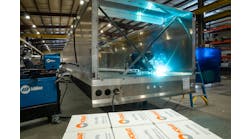Collaboration and communication between equipment manufacturers, their dealers, and customers are especially important during challenging market conditions, suggested a panel of trailer OEM representatives during a discussion at the NTDA convention. Likewise, now more than ever, a forward-thinking approach is critical to managing the lingering challenges of a downturn—and to be in position to seize the opportunities that are coming with the freight rebound.
“I don't see us working out of [the market slump] real fast, but we'll come back and I think it'll be business as usual,” said Bill McKenzie, MAC Trailer Mfg. president of sales. “We were so blessed for the last four or five years, it's been incredible. I think people just lose sight of that, and that this [current market level] is kind of normal. In the fall it gets a little stagnant, and then we get a big rush at the end of the year, and then we get spring orders—it starts moving again.
“So I think it's going to be fine. We’ve just got to be patient, and we’ve got to weather the storm.”
For many trailer customers, however, patience means extending the lifecycle of equipment.
“It comes down to customers making decisions: Do they capitalize, or do they continue to expense maintenance-related items?” suggested Jeremy Sanders, CCO for Stoughton Trailers. “Customers who typically have a shorter replacement cycle are extending that. Interest rates are part of it. Inflation is part of it. It's a difficult time for customers to know what to do. And I don't know that they like it, but sometimes you're forced into it.”
What's coming next?
Looking ahead, however, more than traditional economic cycles will be in play.
“We're going to continue to see technology play a big part in this industry, with customers adopting different elements,” Sanders added. “Think about the efficiency needed a market that is profit constrained. A lot of folks are going to point investments towards making their equipment smarter, making their equipment easier to use, autonomy.
“And, as OEMs, we keep an eye on that as we talk our customers, to understand what they need, and what their customers need.”
Along those lines, vehicle electrification is “a tremendous trend” that isn’t going to go away, added Rob Ulsh, Great Dane v.p., dealer and international sales.
“Where does that technology end up, at the end of the day, and what can we accomplish with it?” Ulsh said. “How can we make it cost effective, efficient, reliable—so that you can actually do operationally what you need to do?”
Ulsh cited the push toward electrification in refrigerated transportation—in response to emissions rules and idling and noise restrictions—as technology that’s already embedded in the supply chain.
On the other hand, one change leads to another, he continued, pointing to zero-emissions equipment resulting in heavier tractor-trailers.
“The biggest concern and ones are the ones they haven't told us about yet. I think as an industry, we've done well over the last answering the challenges that have been put put in front of us as an OEM, but the big 800-pound gorilla in the room still remains environmental, where we end up with the emissions piece,” Ulsh said. “Where do we go with weight and what might that regulation or legislation environment look like as we go forward? That's going to have to be addressed.”
Dealer relations
So how are OEMs evaluating their dealer network during a downturn?
“I’ve been around this industry for a lot of years, and it's hard to pinpoint performance and expect the same thing every year—because the market's not the same every year,” Fontaine Trailer Sr. Director of Sales Al Cox said. “Try to gage that, read into how they're doing. Help them manage the inventory they’re carrying, make sure they’re getting the product they need, when they need it.”
Beyond performance metrics, a “qualitative aspect” is important in evaluating a dealer’s performance, noted Stoughton’s Sanders.
“Service, covering your territory, knowing your customers: What relationships are you building, not just for the quarter we're in or the year we're in, but what does this look like over time?” Sanders explained. “Do we have the right people representing our brand for the future? That matters. That's important.
“We can talk about sales, we can talk about volume, but do we have the right behaviors? Do we have the right team chemistry? Are we going to be able to weather the cycles in this market together? Those are the characteristics that we look for as an OEM.”
MAC does electronic monitoring and evaluations six months, McKenzie noted.
“We like to do personal visits, and it's not necessarily that we do it just to check on them—because we know what the metrics are. Are we doing everything we can do to support you? Is there an issue? Are you ordering enough equipment for the AOR that we've provided?” McKenzie said. “Bug it still comes down to that personal relationship with the distributor, and whether or not it's working for them and it's working for us.”










